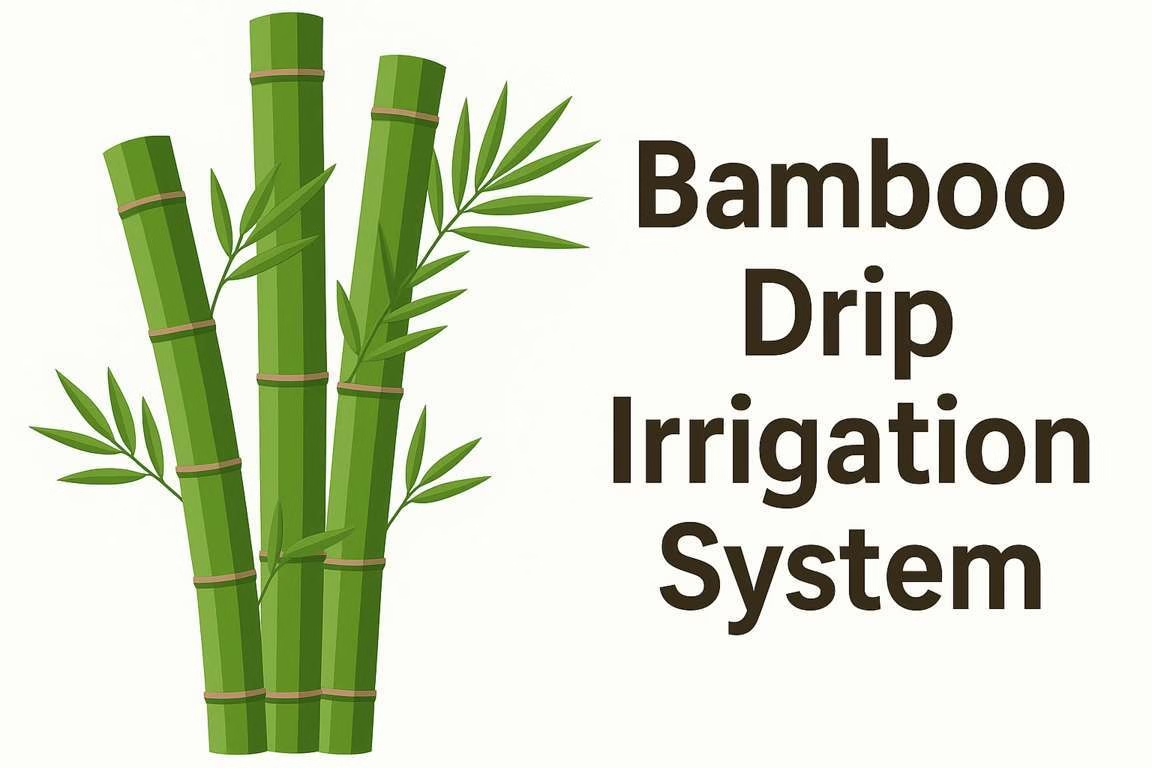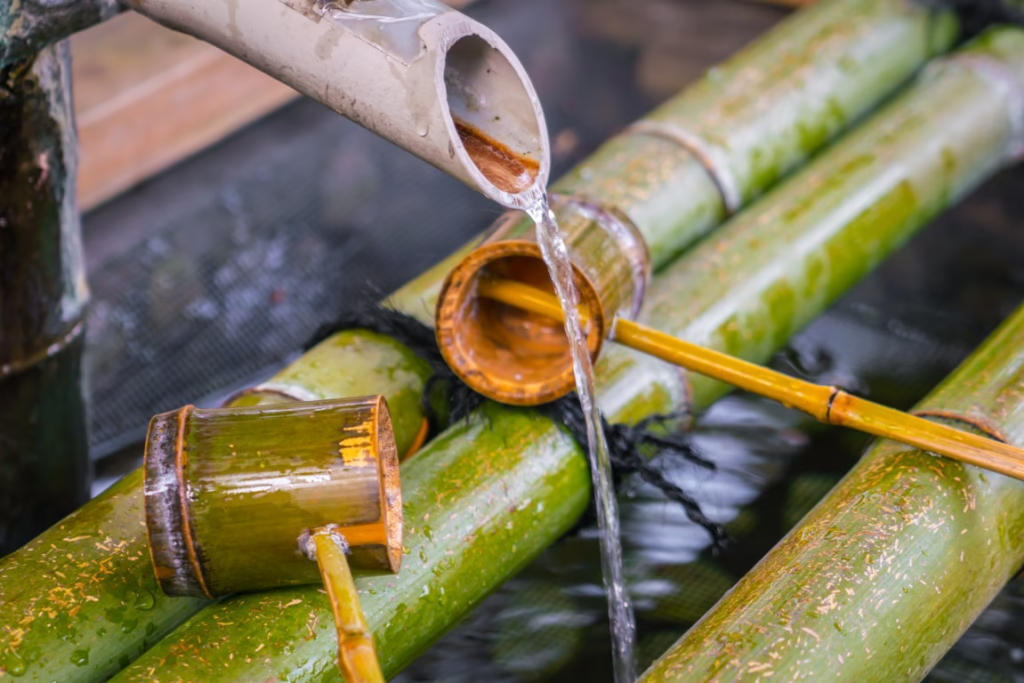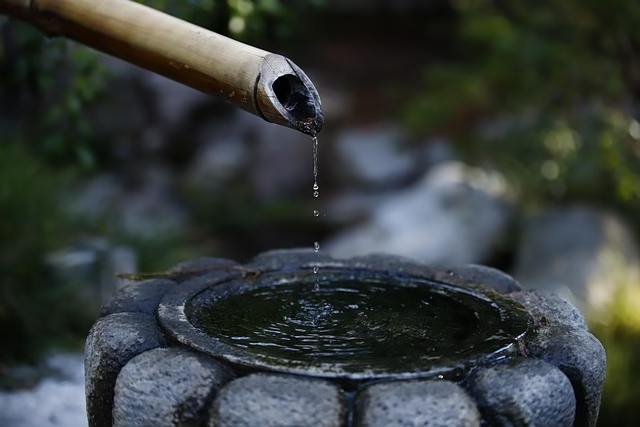
When you hear about the drip irrigation system, a long hose with drip emitters comes to mind.
What if I tell you that you can even set up the drip system without needing a hose? Yes, that’s right.
In northeast India, especially Meghalaya state, it is a practice to build drip systems using Bamboo sticks.
Bamboo drip system is more than the 200-year-old practice of using gravity to supply the water from the sources, which is most of the time from perennial streams, natural springs, or collection ponds.
Ok, now look deep at the Bamboo Drip Irrigation System.
What Is a Bamboo Drip Irrigation System?

A Bamboo drip irrigation system is a low-tech, sustainable method of delivering water directly to plant roots using Bamboo poles, tubes, or segments instead of conventional plastic materials.
This system works on gravity and uses Bamboo’s natural hollow structure to transport water efficiently while minimizing evaporation and runoff.
Unlike conventional irrigation methods that often waste significant amounts of water through evaporation and runoff, Bamboo drip irrigation delivers water precisely where plants need it most – at the root zone, and the system is built with such precision that water wastage due to leakage is minimal.
This targeted approach can reduce water usage by up to 70% compared to traditional watering methods, making it an excellent choice for water-conscious gardeners and farmers alike.
As I mentioned earlier, Bamboo irrigation techniques date back more than 200 years. Here is a brief history of that.
Brief History Of Bamboo Irrigation
The use of Bamboo for irrigation isn’t a new concept. It dates back thousands of years to ancient agricultural practices across Asia. Traditional farming communities in countries like China, India, Indonesia, and the Philippines have utilized Bamboo’s natural properties for water distribution for generations.
In parts of rural China, farmers developed intricate networks of Bamboo pipes that would channel water from mountain streams directly to terraced rice paddies. Similarly, communities in Bali created subak systems – complex cooperative water management arrangements for rice fields – that incorporated Bamboo channels and dividers to distribute water fairly among community members.
What’s fascinating is how these ancient techniques have stood the test of time. The principles behind Bamboo irrigation systems developed centuries ago remain just as relevant today as we search for sustainable alternatives to plastic and energy-intensive irrigation methods.
The Bamboo irrigation method is used in the North East Indian states, mainly Meghalaya, because the system is particularly effective in the hilly terrain of Meghalaya, where the soil has poor water retention capacity and ground channels for water diversion aren’t feasible.

Types Of Bamboo Irrigation System
Not all Bamboo irrigation is the same; however, we can differentiate the Bamboo system from how they are used.
Gravity-Fed Bamboo Pipe Systems
This classic approach uses Bamboo poles as channels to transport water from an elevated reservoir to your garden beds. Like in the hilly terrains of Meghalaya.
The system relies entirely on gravity, requiring no pumps or electricity.
Water flows through the main Bamboo channels and is distributed through smaller Bamboo segments or strategically placed holes that allow water to drip directly at the base of plants. The flow rate can be controlled by adjusting the height of the reservoir or the size of the drip holes.
Bamboo Drip Stakes
This system is not entirely dependent upon the Bamboos. Here, most of the time, only Bamboo stakes are used to deliver the water.
Bamboo drip stakes are individual segments of Bamboo inserted directly into the soil near plants. The top of each stake connects to a water source (often via a header pipe), and water drips slowly from the bottom of the stake, delivering moisture directly to the root zone.
These stakes can be especially useful for container gardening or for targeting individual plants with specific watering needs.
Bamboo Trickle Systems
This type of Bamboo irrigation is practiced in Meghalaya.
Where Bamboo trickle systems use a series of Bamboo segments with small holes or slits that allow water to trickle out slowly along the length of the Bamboo.
These are typically laid alongside rows of plants, providing consistent moisture along planting beds.
Materials Needed for a Bamboo Drip Irrigation System
In the Bamboo irrigation system, it’s all craftsmanship, how precisely Bamboos are cut so the water is not wasted, and how effectively water is handled needs a special hand, soit needs a lot of tools to build it.
Here is the list of those tools and materials:
Essential Materials:
- Bamboo poles (various diameters depending on your system design)
- Hand saw or Bamboo cutting tools
- Waterproof natural twine or plant-based cordage
- Natural waterproof sealant (beeswax or plant-based options)
- Drill with various bit sizes
- Water reservoir (bucket, barrel, or tank)
- Stand or platform to elevate your water reservoir
Optional Materials:
- Small stones or pebbles (for filtration)
- Coconut fiber or natural cloth (for filtration)
- Clay pots (for olla hybrid systems)
- Bamboo splitter tool
- Natural rubber washers (made from rubber tree sap)
- Wooden plugs
These are all the tools and materials you’ll need to build a Bamboo Drip system. Another important aspect is choosing the correct Bamboo for optimum irrigation.
Selecting the Right Bamboo
Not all Bamboo is created equal when it comes to irrigation systems. Here’s what to look for when selecting Bamboo for your project:
Species Considerations
While many Bamboo species can work for irrigation systems, some have characteristics that make them particularly suitable:
- Phyllostachys species:
Known for straight culms and thick walls, making them durable for the main water channels
- Bambusa species:
Often have larger diameters, useful for primary water delivery
- Dendrocalamus species:
Extremely strong and durable, good for long-lasting systems
Benefits of Bamboo Drip Irrigation
Sustainable Material
Did you know that Bamboo is the fastest-growing plant on earth? It can grow 91cm (3 feet) in a single day!
So you can use the Bamboo in a matter of days unlike other plants that take a decade to grow and mature.
Additionally, Bamboo:
- Grows without the need for pesticides or fertilizers
- Requires minimal water to thrive
- Produces 35% more oxygen than equivalent stands of trees
- Has an extensive root system that prevents soil erosion
- Continues growing from the same root system after harvesting, eliminating the need for replanting
Water Conservation
Water scarcity is a global concern where traditional plastic used water systems have different setups and can cause water runoff and evaporation.
Where in the Bamboo irrigation is designed to deliver water directly to the base of the plants, reducing evaporation and runoff. It’s estimated that 18-20 liters of water per minute entering the main channel gets reduced to 20-80 drops per minute at the end of the network. This ensures efficient use of water.
Plastic Reduction
For the environment, plastic is the biggest enemy, and the conventional drip irrigation systems rely heavily on PVC and polyethylene tubing that will eventually end up in landfills or, worse, in our oceans.
When you consider that the average plastic drip irrigation system contains hundreds of feet of plastic tubing that needs replacement every few years, the environmental impact becomes clear.
By contrast, Bamboo irrigation systems provide a biodegradable alternative that will naturally decompose at the end of its useful life.
Long Lasting
Another characteristic of Bamboos is that even with the rapid growth, it has lasted for many years.
Once set up, it doesn’t require constant monitoring or manual intervention to ensure its operation.
Drawbacks of Bamboo Drip Irrigation
Not Suitable for Every Landscape
Bamboo drip irrigation is well-suited for hilly areas where water is sourced naturally from streams or springs. And gravity can be used to transport the water.
In a drought and reduced rainfall, and a flat surface, the system may not function well.
Maintenance
Even though the initial setup is easy, the system needs regular maintenance.
Bamboo channels are susceptible to damage from weather and pests over time, necessitating periodic replacement or repair of the channels.
The small holes in the Bamboo channels, which allow the water to drip out, can get clogged due to sediment or debris in the water. So it is your duty to monitor the system so it isn’t affected by the debris.
Not Suitable for All Plants
Bamboo drip irrigation delivers water directly to the plant base, limiting the wetted area to a small root zone. This localized watering may not be ideal for plants with extensive root systems or high water demands.
Comparing Bamboo with Conventional Drip Irrigation
| Feature | Bamboo System | Conventional Plastic System |
|---|---|---|
| Initial Cost | Lower if Bamboo is locally available | Higher due to manufactured components |
| Installation Complexity | Moderate to high, requires craftsmanship | Low to moderate, standardized parts |
| Water Efficiency | Very high (70-90%) | High (70-90%) |
| Environmental Impact | Minimal, biodegradable materials | Significant plastic waste |
| Lifespan | 3-7 years with maintenance | 5-10 years |
| Customization | Highly customizable | Somewhat limited by available parts |
| Maintenance | Regular inspection and occasional replacement | Less frequent but eventual plastic degradation |
| End-of-Life | Compostable | Landfill or recycling facility |
Last Words…
An old and preserved irrigation technique is Bamboo Drip irrigation. By implementing these systems, you’re not only nurturing your plants more effectively but also contributing to water conservation efforts and reducing plastic waste.
However the reality is even if you want to implement the Bamboo drip system you’ll face many challenges. The first one is suitable raw materials and the experienced hands that build these kinds of systems.
I encourage you to start small, perhaps with a simple Bamboo drip system for your favorite plants, and gradually expand as you gain confidence in working with this remarkable natural material. Your plants, your water bill, and the planet will all thank you for it.

Leave a Reply